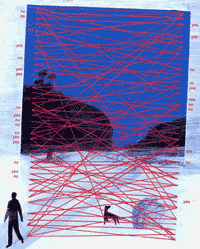
My wife and I were travelling in the car this morning listening to CBC Radio One as we usually do. We were listening to an excerpt highlighting a lawyer questioning a witness at an inquiry about the use of Agent Orange in New Brunswick since the 1950s. This particular lawyer, like every stereotypical lawyer, insisted that the respondent answer either yes or no. At the time, I commented to my wife that lawyers idiotically simplify reality by insisting on yes-and-no answers to questions when reality is not so binary.
Later in the afternoon, I was watching a taped lecture by a visiting physicist at the Perimeter Institute by the name of Anton Zeilinger from the University of Vienna. Imagine my chagrin when I looked up an article he recommended we read from the NewScientist entitled “In the beginning was the bit”. Why? Because in that article the author summarizes one aspect of Zeilinger’s theory with the phrase “we can only interrogate nature the way a lawyer interrogates a witness.”
Not only does Zeilinger apparently take me to task for disparaging lawyers the way I did this morning, but he also reminds me that the “I in IT” is information. But perhaps I’m taking this too personally. Zeilinger is important because he answers fundamental questions about why physics is quantised (light comes in photons, electrons come with fixed energy levels, etc).
But it isn’t because he is acting like a prosecuting attorney in a court of physics by demanding yes-and-no answers. In fact, there is nothing really new about an information theory which suggests bits of information can be reduced to 0s and 1s – that’s simply classical information theory. Zeilinger (and his partner Brukner) has proposed another measurement called total information in which the information about an entangled 2-bit pair always includes the effects of measurement. In other words, the total information content in such a system always comes to two bits, not one. This is what physicists call an Urprinzip, or foundational principle for quantum mechanics. It may become one of the key principles of the 21st century.
This makes me much happier. The reason why lawyers ask for yes-and-no answers to their questions is because they want to reduce reality, presumably to make it easier for either the judge or the jury to make a decision about guilt or innocence. In that endeavour, it is obvious to most people that they are distorting reality to achieve their goals.
But physicists and IT managers do the same things, albeit with different tools. When a physicist measures an elementary system, he/she can only answer one question with a yes-or-no answer. The rest is uncertain (Heisenberg’s Uncertainty Principle). Classical computers and classical IT managers work along these lines too. Classical computers only deal with on/off, yes/no, true/false. IT managers draw process diagrams and flowcharts all of which are predicated on yes-and-no answers too. So, really, our technology and our managers are no better than the lawyers.
Quantum physics, and perhaps all reality, Zeilinger argues, has to work this way. What this means, then, is that information itself underscores everything we think we know about reality. The RBQ (Really Big Question) therefore becomes not “What is an elementary system?” but “What can be said about an elementary system?”
I really don’t know what all this means in practical terms for the everyday life of an IT Manager, but it is somehow comforting to think that there may be good reasons why reality at all levels is so uncertain, so complex, and so human.

No comments:
Post a Comment